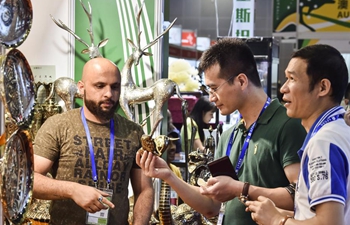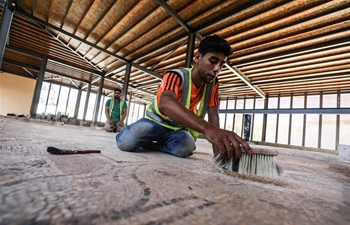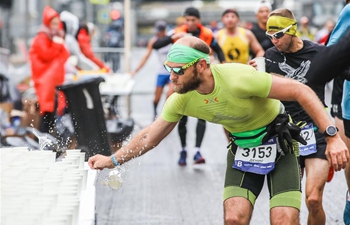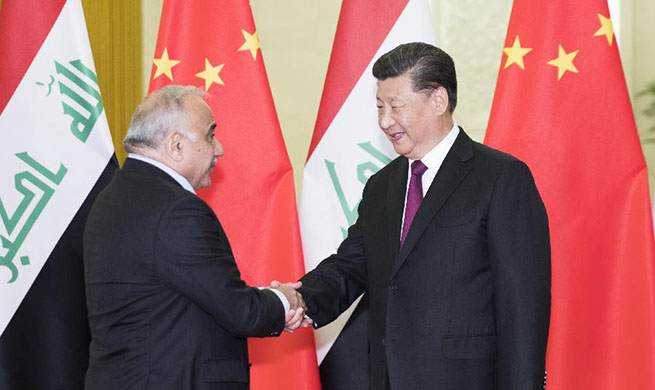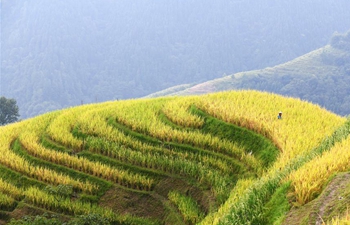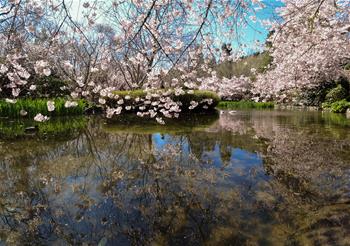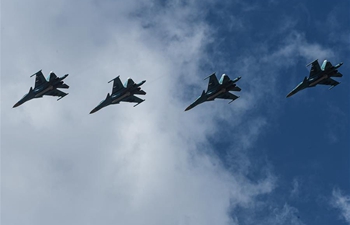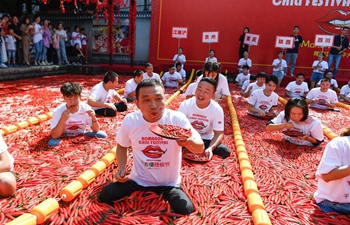JINAN, Sept. 24 (Xinhua) -- Ma Jiqing, 72, is a man who looks on the ground in search of a sixpence while not missing the moon.
Farming and painting may be irrelevant, with one being down-to-earth and the other high-end, but for Ma, they are what he has been doing for the past 50 years.
As a farmer-turned painter, he has painted the development of the country's rural areas by depicting scenes of rural life, bountiful harvests, satisfied families and more.
With the arrival of the second Chinese farmers' harvest festival on Monday, Ma, who lives in Qingzhou in east China's Shandong Province, has his own way to celebrate -- painting several new pieces.
On one of his paintings, stacks of bountiful corn harvests dwarf mountains. "These paintings are a salute to all farmers and the festival," said Ma.
Typical farmer paintings are hand-painted with gouache watercolors on paper. With brilliant and vibrant colors, thick lines and exaggerated figure patterns, they are a way for Chinese farmers to depict their vivid rural life and express their views.
Apart from being a farmer, Ma is also a contracted painter of a farmer painting institute in the county-level city of Qingzhou. In his workroom, paintings of different sizes hang on the wall.
"This one earned a national award," said Ma, while pointing to a painting which covers half a wall.
"Unlike many farmer paintings featuring red and yellow, this used different shades of blue. It depicts the repealing of agricultural tax and a scene of farmers celebrating the event," said Ma.
In 2006, the Chinese government announced the abolishment of various kinds of agricultural taxes and fees, ending a 2,600-year-old agricultural tax.
"Farming life has given me endless inspiration for my art creations," he said.
Ma has enjoyed painting since he was little. Because his family was so poor, the cornfield was his workroom, and borrowed comic books were his teachers.
"When my parents were farming, I liked to draw them on the back of my notebook. And I traced patterns on comic books to learn skills," he said.
In his twenties, Ma worked and dried tobacco leaves in a local production team, formerly the basic farming unit in the commune system of China. When he was informed that the local government needed people to paint farming-themed frescoes, he signed up right away.
To make time for painting, Ma asked his colleague to switch shifts with him. In the following two weeks, he painted during the day and worked at night, barely having time to sleep.
"I did not realize it was farmer painting. I just enjoyed painting rural life," Ma said.
In China, frescoes were often painted colorfully on the exterior walls of farmer houses and stone bridges, to inform people of the latest government policies or to express people's dreams for a better life.
These days, frescoes dating back to the 1960s and 1970s can still be found in Qingzhou and other national-renowned farmers painting villages such as Huxian County in northwestern Shaanxi Province and Jinshan District in Shanghai.
Farmer painting originates from ancient traditions of wall painting, paper cutting, and embroidering, but the style of farmer painting emerged in the second half of the 20th century.
In the 1980s, farmer painting was unpopular, as the country's rapid economic growth created more competing genres. In the 1990s, it regained some momentum as cultural development stepped up.
Now in Qingzhou, more than 30,000 people are engaged in farmer painting. Many of them run online stores selling paintings and cultural and creative products.
The farmer painting industry generates revenue of over 50 million yuan (about 7.1 million U.S. dollars) annually for the city, according to Wang Ying, an official with the Qingzhou Farmer Painting Institute.
Chinese grassroots art is also recognized internationally. From 2015 to 2018, the institute organized three exhibitions in France, the United States and the Republic of Korea.
"Compared with traditional Chinese painting, farmer painting is more direct and vivid and thus is easier for people from different cultures to appreciate," said Wang.
"I prefer to be called 'farmer' instead of 'artist' and the farmland will always my spiritual home," Ma said. "Canvases are my fields, and I want to come up with more drawings to better reflect the aspirations of farmers."





